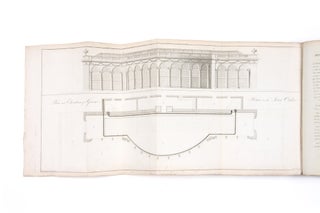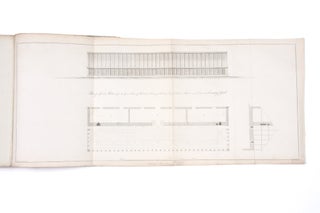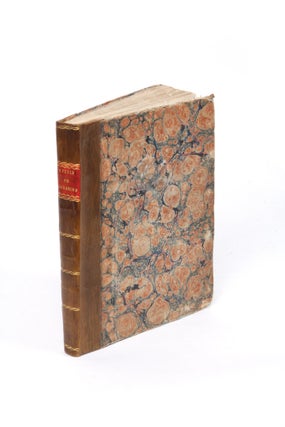An Essay Upon Gardening, containing a catalogue of exotic plants…
An Essay Upon Gardening, containing a catalogue of exotic plants for the stoves and green-houses of the British gardens…
York: G. Peacock, 1793.
Quarto, with three folding plates, early marbled boards, calf spine renewed.
Cook plants, preserving seeds on voyages, and building greenhouses
A singular work written and published at the cusp of the fashion for the cultivation of imported exotics, which provides a most interesting overview of the state of play in England in the early 1790s. It concludes with a two-page notice on the "Directions for the Preservation of Seeds, &c." on long voyages. Richard Steele, a Yorkshire gardener who lived and worked around Thirsk, wrote this as "an attempt to aid in the management of that most elegantly-refined and fascinating department of the Garden, where the prodigious variety of rare plants that have been introduced into this kingdom, from the hot regions of the terraqueous globe, are deposited…".
A singular work written and published at the cusp of the fashion for the cultivation of imported exotics, which provides a most interesting overview of the state of play in England in the early 1790s. It concludes with a two-page notice on the "Directions for the Preservation of Seeds, &c." on long voyages. Richard Steele, a Yorkshire gardener who lived and worked around Thirsk, wrote this as "an attempt to aid in the management of that most elegantly-refined and fascinating department of the Garden, where the prodigious variety of rare plants that have been introduced into this kingdom, from the hot regions of the terraqueous globe, are deposited…".
What is immediately noticeable is that while there are established collections from the East and West Indies, and while British gardens were beginning to have really substantial collections of Cape plants, there is still only a handful of Australian plants available for cultivation. Published in the same year as Smith's Botany, this work describes six Australian plants, all apparently collected before the First Fleet era. The Eucalyptus obliqua noticed by Steele, for example, was the first major plant to be routinely noticed as growing in England, and is known to have been collected in Tasmania by Furneaux in 1774 and Cook in 1777, being first figured in France in 1788. Thus, while Steele's work includes notes on how best to grow each species, most of the notes on Australian plants display some uncertainty, as with the entry on the eucalpyt: "I cannot speak with certainty as to the propagation of this plant; but most of the South Sea woody plants will grow from cuttings, with the same treatment as cuttings from plants of similar latitudes in the other hemisphere."
The book also includes a most interesting essay on how to get the best out of the "Stove", recommending that one about 160 feet long (!) would be appropriate for "containing a prodigious collection of plants for the satisfaction of the curious." The essay on the Stove dwells particularly on the growing of grapes and vines, with asides on exotic fruits such as the pineapple, at this time beginning to be regarded as the pinnacle of the art of the exotic gardener. In this regard the three plates are significant, the first two reproducing Steele's notion of the ideal stove and greenhouse, while the third shows the more modest greenhouse actually built by Richard Anthony Salisbury, of note because he was one of those who did in fact cultivate Australian plants, and who published with William Hooker the Paradisus Londinensis (1805-1809).
The subscribers -- some 275 of them -- would probably have accounted for the bulk of the edition, and it has proved to be rare on the market. Steele's essay was published in York, and there is certainly a northern bias to the subscribers: it's not often that a work of this type and date would have been subscribed to by folks such as "James Banks, Esq., of Pontefract", but not his namesake Sir Joseph. Many are gardeners to large estates, or architects, and there are a goodly number of other middle class professionals: surgeons, attorneys, and the like. Among his contemporaries Richard Anthony Salisbury is probably the most prominent, and there is also the Duke of Portland, whose house Bulstrode was a centre for natural history in this era, largely due to the efforts of Margaret Bentinck, Duchess of Portland (1715-1785).
Provenance: Marmaduke Jerard Grimston, of Grimston Garth and Kilnwick (1826-1879, like the author a Yorkshireman), with his armorial bookplate.
Henrey, 1384.
Condition Report: Some light scattered foxing.
Price (AUD): $6,400.00
US$4,125.41 Other currencies






